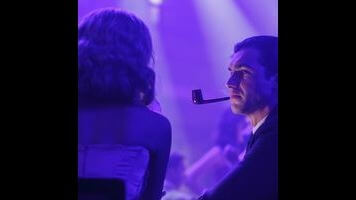The life of Hugh Hefner is not exactly uncharted territory for documentary filmmaking, as several feature-length explorations of the subject already exist. It’s not beyond the realm of possibility that a fictionalized series based on Hefner and the rise of his Playboy empire could fill the Mad Men void in our lives (although we have the short-lived 2011 series The Playboy Club to suggest otherwise). An attempt at fusing those two approaches, the 10-part hybrid series American Playboy: The Hugh Hefner Story weaves archival footage, new interviews, and dramatic re-enactments into a shoddy tapestry.
Granted, it would be dishonest and somewhat pointless to produce a Hugh Hefner series devoid of female nudity. The founding of Playboy magazine, as we learn in the first episode, stems from Hef’s love of Esquire and its evocation of a sophisticated world he longed to inhabit (as opposed to the other men’s magazines of his youth, which mostly catered to the hunting and fishing crowd). In addition to literature, fashion, cartoons, and lifestyle tips, Esquire included pinups of scantily clad women, albeit of the hand-drawn variety. Once Sexual Behavior In The Human Male (the first of what are better known as the Kinsey Reports) was released in 1948, it became clear to Hefner, then the editor of his college humor magazine Shaft, that there was “more sex going on than people admitted.” He added a feature called “Co-ed Of The Month” to the magazine, foreshadowing his career-defining innovation.
After college, Hefner landed his dream job writing copy for Esquire, but the magazine had grown more conservative in the 1950s, and he found the desk work stifling. In 1953, he set about creating his own dream version of a men’s magazine, a more liberated Esquire that would include a flesh-and-blood pinup girl as its centerpiece. It was a true DIY operation with a handful of investors and trusted collaborators. Central to Playboy’s creation myth is that the first issue included as its centerfold none other than Marilyn Monroe, who had posed nude for a calendar company several years before becoming famous. This epochal event is re-enacted as the most matter-of-fact transaction possible, with Hef tracking down the calendar company, offering to buy the photo, and… buying the photo.
This is typical of the dramatic re-enactments, which star New Zealand actor Matt Whelan as Hefner. It’s impossible to say whether Whelan gives a good performance, as there are very few actual scenes that play out from beginning to end. Instead we get snippets illustrating what we’ve just been told by an interview subject or B-roll footage running under a voice-over just because something has to be on the screen. (The first two episodes alone feature countless shots of Hef jotting notes on a pad in his office or a bar.) Whelan only vaguely resembles Hefner both physically and vocally, and none of the other major players are able to do much with their thinly sketched roles.
The real Hugh Hefner did no new interviews or narration for the series, but he appears throughout the first two episodes courtesy of clips from other sources. Family members and longtime loyal business associates are interviewed, as are celebrity admirers like Bill Maher, Gene Simmons, and Brett Ratner—in other words, just the sort of celebs you’d expect to be Hef fans. (The major exception is Jesse Jackson, who praises Hefner for giving a platform to civil rights struggles in the ’60s.) Again and again we’re told Hefner is a trailblazer, a maverick, an American original, a crusader for sexual liberation, a soldier in the First Amendment wars. And all of that is certainly true. The cultural influence of Playboy on several generations of Americans can hardly be overstated.
There are voices we never hear in American Playboy, though, at least in the first two episodes: the voices of women who aren’t related to him, weren’t married to him, or didn’t work for him for decades. Perhaps later episodes allow more room for dissent, but through the first two hours, American Playboy is a sponge bath for Hef in his grotto. Some faults are acknowledged (“I was never home with my family”) but quickly excused (“I was always at work, and anyway, my parents never showed me love”). Any suggestion that Playboy mostly appealed to an adolescent male vision of sexuality that reduced women to centerfolds is quickly dismissed. That’s about what you’d expect from a fully authorized portrait, but the cheesy production is a little surprising. American Playboy looks like something you’d find on History or Reelz rather than Amazon—except, of course, for all the bare breasts, without which the series wouldn’t even exist.










![Rob Reiner's son booked for murder amid homicide investigation [Updated]](https://img.pastemagazine.com/wp-content/avuploads/2025/12/15131025/MixCollage-15-Dec-2025-01-10-PM-9121.jpg)

























![HBO teases new Euphoria, Larry David, and much more in 2026 sizzle reel [Updated]](https://img.pastemagazine.com/wp-content/avuploads/2025/12/12100344/MixCollage-12-Dec-2025-09-56-AM-9137.jpg)




